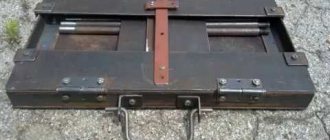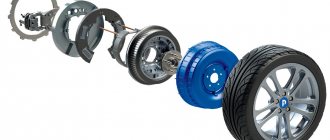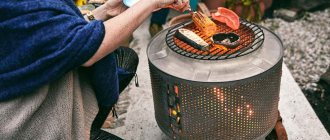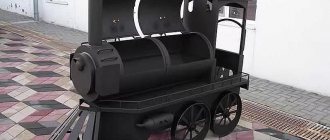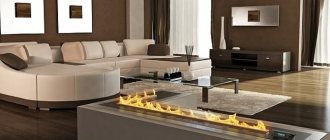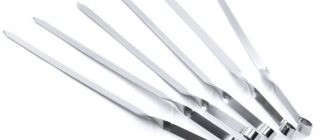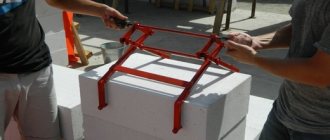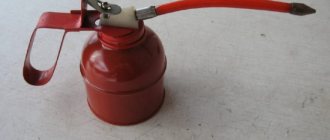Owners of personal plots strive to equip a recreation area with a barbecue complex. Construction is expensive, so craftsmen equip the place with their own hands using the material left over after repair and construction work. A barbecue made from blocks is the best way to save money.
The barbecue area, equipped on the site, includes a grill, a woodshed and tables
Projects and drawings of barbecues and barbecues made from blocks
Construction of a place for a family vacation begins with choosing a site. The location of the barbecue area should be convenient so that:
- you could bring food from home;
- there was a covered canopy to provide shelter during a sudden rain;
- there was a distance from neighbors so that noisy company would not interfere with rest.
A sketch of the recreation area is drawn on paper, and then measurements are taken and a detailed drawing is made.
A barbecue is built from blocks according to a photo or video instruction. A mini utility unit installed in the recreation area will help you conveniently store firewood, skewers and kitchen utensils for outdoor cooking.
The base is calculated based on the desired dimensions of the firebox
The fireplace exceeds the perimeter of the base by 15-20 cm. Based on the needs and size of the area, determine the perimeter of the barbecue area.
The grill is combined with a grill, cauldron, barbecue and smokehouse
When planning, the distance from the house, neighboring plots and water supply is taken into account. If desired, water and drainage are connected to the grill area and a sink is installed.
A multifunctional barbecue complex allows you to cook right on the street in a noisy company of friends and family
Small plots limit the size of the recreation area, so summer residents build a small complex of barbecue, woodshed and table with their own hands. Small structures do not require a chimney.
The multifunctional barbecue complex is complemented with a chimney, decorated with arches and columns
Material for production
A barbecue with a table should be made from certain materials. Best suited for this purpose:
- Sheet iron 2-3 mm, if welding is used in manufacturing. Iron 1.5-2 mm in case the assembly is on screws or rivets;
- Boards;
- Concrete or tiles.
For the legs you will need a 15 mm and a steel or aluminum pipe.
Aluminum sheets are not the best choice because they will warp greatly from the heat. Welding stainless steel requires unique electrodes. The thickness of the metal must be strong, but at the same time light, always more than 2 mm, otherwise the metal will warp and it will quickly burn out.
Tools and sizes
You also need to make sure you have the necessary tools in advance:
- Welding machine, drill, grinder, tape measure, jigsaw, screwdriver;
- Silicone sealant, wood varnish, wood glue, wood paint;
- Protective gloves and mask;
- Self-tapping screws, bolts, nuts, drills;
The dimensions cannot be universal, so you will have to arm yourself with a tape measure and measure the expected location of the table in the selected place. Then count how many skewers you plan to put on the grill, how many guests the table is designed for.
If the company is large and you plan to simultaneously cook barbecue and use the barbecue grill (for cooking vegetables, for example), take this into account in the dimensions. You need to start with a drawing, on which you need to reflect all the smallest details.
Also take into account whether you will be transporting the table; in this case, there is no need to make the table heavy and provide special wheels or runners. A correctly assembled structure will not lose its geometric shape for almost the entire service life.
It is also necessary to take into account that problems may arise during operation. The main points are the possible excess of the permissible temperature, too much weight and, of course, the extent to which it is intended to be used in adverse weather conditions (if the table is not mobile).
What can you build a grill from?
A stationary barbecue made from blocks in the countryside, made by yourself, is distinguished by its reliable design, strength and durability. Often it is equipped from materials left over from the construction of the house. Concrete blocks are no exception.
The advantages of the material are as follows:
- high strength;
- weather resistance;
- durability;
- frost resistance;
- quick and easy installation;
- low consumption of cement-sand mortar;
- efficiency.
Attention!
Concrete is a flammable material, so the firebox is made of fireclay bricks or a metal structure. Purchased models of barbecues are not much different, so owners of personal plots try to build an individual structure. Combined structures include not only blocks, but also brick or metal. Modern manufacturers offer a large selection of building blocks:
- Foam blocks are made from foaming agent, cement, sand, water and hardener.
Fine-grained foam block material does not hold nails and screws - Aerated blocks are made from cement, sand, gypsum, metallurgical slag, lime and water.
Aerated blocks do not shrink, but their disadvantages include high moisture absorption - Cinder block contains ash, slag or shell rock.
Cinder block is hygroscopic, therefore it is prone to the formation of mold and fungi
Is it possible to assemble a barbecue from expanded clay concrete blocks?
Recently, the construction of barbecues from aerated concrete blocks has become widespread. However, expanded clay concrete is made from foamed and fired clay. The material is light, strong and durable. Experts highlight some advantages of expanded clay concrete:
- resistant to atmospheric influences and sudden temperature changes, frost-resistant;
- hygroscopic;
- environmentally friendly, because it is made from natural materials, without the addition of household chemicals;
- ease of installation: laying one block is comparable to laying seven bricks;
- economical in cost;
- does not support combustion, which means it can be used to build a barbecue;
- resistant to the formation of fungus and mold.
Features and purpose
The basis of the barbecue design is a box, inside of which there is a tray for coals and a grate for cooking food. High sides protect the heat from blowing out, and it maintains the temperature, heating the sides themselves.
This kind of design allows not only to speed up the cooking process, but also ensures uniform roasting, and also prevents overdrying and burning of food.
The undeniable advantage of a barbecue is its versatility , both in terms of design and the ability to prepare various dishes and products. You can use it to cook not only barbecue, wings and any type of meat, but also more ordinary everyday dishes from soup to baked fish. In addition, it is ideal for quickly drying mushrooms and fruits. A homemade grill in the country will certainly become an indispensable thing. To make it yourself, you need to select suitable projects, drawings and follow the advice of experts.
Where is it better to build a barbecue area and grill?
Before arranging a place to relax, experts advise studying the recommendations for constructing a barbecue area from blocks with your own hands. When planning, take into account the location:
- to the fence from 1 m;
- to bushes or trees from 3 m;
- 3-5 m to a residential building.
A path is laid to the barbecue complex from the house, utility block and other buildings
Where to place it?
Proper placement of a barbecue is a matter of not only convenience and beauty, but primarily safety.
The basic requirements for the location of the barbecue are the same for all models, namely:
- Smooth surface;
- there should be no flammable objects (buildings, plants, cars, etc.) nearby;
- distance from a residential building by 5–15 meters;
- providing protection from rain under a canopy or roof;
- wind rose (the direction of the smoke should be in the opposite direction from the residential building).
Don’t also forget that the intense heat from a barbecue can damage any vegetation, so you shouldn’t place it surrounded by flower beds or garden beds. Not only the appearance of the landscape will suffer, but also the crop. It’s also better to think in advance about the path to the barbecue from the house and the recreation area.
What tools and materials will be needed
After planning the site and creating a project, they begin to prepare the necessary tools and materials. To build a barbecue from blocks and bricks with your own hands you will need:
- blocks;
- fire brick;
- cement, sand, clay, lime for mortar;
- boards or plywood for arranging formwork;
- fittings made of metal or fiber optics;
- grate, door and other oven accessories;
- shovel;
- level;
- screwdriver and screws;
- decorative material.
Construction of the barbecue foundation
The barbecue foundation is made shallow, such as a strip or slab. In this option, a slab foundation in the form of a solid concrete slab is chosen.
For such a foundation, a shallow pit is made. Hydrotextiles and a sand cushion are placed at the bottom of the pit. The sand is pressed.
The pouring of the foundation slab is done after installing the formwork with the installation of a reinforcement grid in the formwork.
Concrete is poured directly into the level. To simplify leveling, it is better to make the upper level of the formwork along the upper level of the foundation.
How to make a prefabricated grill from concrete blocks
The construction of a barbecue oven from blocks with your own hands begins with clearing the site. Debris and grass are removed and the turf is removed.
Step-by-step instructions for carrying out the work:
- Markings are made on the cleaned, prepared area. Pegs are installed around the perimeter and string is pulled. According to the markings, remove the top layer of soil, deepening it by 20 cm.
Gravel and sand 5-10 cm high are added to the bottom - Formwork is installed around the perimeter. At the corners and in the center of the sides, stakes are driven in from the outside and the structure is secured using self-tapping screws with a screwdriver. A mesh of reinforcement is laid at the bottom. Filled with concrete.
Concrete mortar is made in the proportions of one part cement to 3-4 parts sand - According to the drawings, the first row of blocks is laid out. Cement-sand mortar is made in a ratio of 1:3.
To ensure that the next tier is securely fixed, a piece of reinforcement is inserted into some cells of the block - After laying the second row, they begin to arrange the formwork. Crushed stone is added to the solution of cement and sand. This will make the structure more dense. The concrete is left to mature for 10-14 days, watered daily.
A metal corner is placed at the base to prevent concrete from splitting when the firebox heats up. - After the concrete has hardened, the formwork is dismantled. Install the grate.
Pieces of metal reinforcement are welded to the corner or a ready-made grate is installed - The firebox is made of refractory bricks. For coupling, prepare a clay-sand mixture or buy ready-made concrete for braziers. A metal corner is used to make an edging around the brick firebox.
The solution is prepared from clay, sand and lime in a ratio of 1:3:0.25 - To make a DIY block grill look attractive, it is decorated with plaster. The structure is painted in a suitable color.
In addition to plaster, stone or porcelain tiles are used for decoration.
Construction stages
The first stage of bringing an idea to life is design. First you need to make several sketches, choose the best one, determine the size and design, draw up a drawing, calculate materials and list of tools. In the future, construction should be carried out in stages, observing the technology for handling solutions and solid compositions. Work must begin with a clear, well-thought-out plan of action and all the necessary materials.
Construction site arrangement
It is best to carry out construction in the warm season, when the ground has dried out and settled after winter heaving, and frost is still far away. The best option for the middle zone is May-September.
To build a barbecue from foam blocks with your own hands, you will need the following devices:
- welding;
- Bulgarian;
- shovel;
- level;
- roulette;
- square;
- mixer;
- drill.
Construction materials Materials
:
- fittings;
- steel corner;
- mixture for concrete;
- blocks;
- glue;
- roofing felt;
- metal sheet 4-6 mm.
To prevent injury, you need to wear assembly glasses and gloves.
The practical part begins with preparing the site. Markings are carried out, a place for the foundation is identified, and the path is traced. Then the grass is mowed, trees are cut down, stumps and bushes are removed. Then communications are installed and garbage bags are prepared. If necessary, a temporary tent can be set up.
Foundation organization
A pit is dug under the foundation.
Since foam blocks weigh little, a powerful foundation is not required for the finished structure. On dense and stable soil, it is enough to lay out a platform of brick and concrete slabs. If the earth is prone to heaving, this problem needs to be approached more thoroughly.
Step-by-step instructions for arranging the foundation:
- Digging a pit 30 cm deep. Removing plant roots and stones. Leveling and compacting the bottom.
- Laying geotextile fabric in the pit. It will prevent erosion of the bedding and the germination of grass and shrubs.
- Organization of the pillow. First, 15 cm of sand is poured, wetted and leveled. A layer of fine crushed stone 15 cm high is poured on top.
- Installation of formwork. Boards are used, the top of which rises 10 cm above the ground. The edges need to be well aligned to be used as beacons.
- Laying the iron frame. Reinforcement or steel mesh is used. The structure is fixed on spacers.
- Preparation and pouring of concrete. The surface is leveled and covered with film. When the mixture becomes hard, but somewhat loose, you can grind off the sharp corners to avoid chipping and injury.
Depending on the temperature, it will take 7-10 days for the slab to gain strength.
BBQ masonry
The foundation is waterproofed using mastic.
When the concrete has completely hardened, work can continue.
Furnace laying sequence:
- Removing formwork. Laying waterproofing in the form of mastic or roofing felt.
- Laying 2-3 rows of stones in the shape of the letter “P”. A corner and rods or a steel plate with holes are laid on top of the blocks. This is a grate.
- Draw two more rows. This is how the firebox is formed.
- Carrying out finishing, since foam blocks are not intended for contact with fire. Fireclay bricks are glued on the inside, and ceramic tiles on the outside.
- Manufacturing and laying on the surface an iron frame from a corner or channel. It will be the basis for skewers, grates or hob.
For a metal top, it's better to use stainless steel so you don't have to constantly fight rust.
Joining seams
A mixture of fireclay clay, sand and cement should be used as a binding mortar for masonry. This composition tolerates strong heat and low temperatures well. Leveling the solution is carried out immediately after the completion of the next row, before the hardening process begins. The jointing is carried out flush with the surface or with figured grout, giving the seams a semicircular profile. The choice depends on the tastes of the owners.
Weather protection
To protect the barbecue from natural phenomena, you can build a canopy with a chimney.
From water, wind and ultraviolet radiation, the barbecue can quickly become unusable. To protect from external factors, you can make a hinged lid or build a canopy with a chimney. During periods of absence, it is recommended to cover the grill with a tarpaulin or plastic cover. In wet areas, the foundation should be raised higher.
Decorative finishing increases the degree of protection and makes the grill more beautiful. You can decorate the structure with facade plaster, pebbles, pieces of glass, beads, artificial stone, clinker. The choice is determined by the configuration of the building and the style of the site.
How to make a barbecue complex from aerated concrete
Do-it-yourself construction of a barbecue from a gas silicate block is gaining increasing popularity. The material allows you to construct structures of various shapes and is easy to saw without chipping. The construction of a barbecue complex with your own hands is carried out in several stages.
Preparing the rough foundation
Markings are made in the prepared area according to the drawings. The top layer of earth is removed along the perimeter to a depth of 20 cm. Lay aerated concrete blocks. Check the level. Gas blocks are fixed using a cement-sand mixture made in a ratio of 1:4.
Vertical seams are secured using thin-layer adhesive
Laying a finished base of aerated concrete
Gas blocks are laid on top of the rough layer using thin-seam glue. Blocks 15 cm thick are used for the base.
The evenness of the masonry on the horizontal surface of the blocks is checked using a building level
Laying gas blocks
Following the drawing, they lay out the woodshed, firebox and chimney. In order for the gas blocks to be reliably connected into a single structure, a number of rules are followed when laying the blocks:
- the width of the trowel is equal to the width of the gas block;
- Before applying the glue, the surface of the gas block is cleaned with a spatula and a brush;
- glue is applied to each joint;
Attention! If the glue sticks out during laying, do not lubricate it, but wait until it dries completely, then cut it off with a knife.
Construction of a firewood shed
Three rows of gas blocks are laid sequentially on the prepared base, following the drawing. Blocks 10 cm thick are used for the back wall, and 15 cm thick for the partitions.
Each block is checked with a level so that there is no distortion of the structure in the future.
Installation of barbecue firebox
To construct the firebox, a horizontal base is created from gas blocks 10 cm thick. Blocks 15 cm wide continue to be laid vertically on top of the base. The back wall is laid out from blocks 10 cm thick.
The last row is processed with a sanding board to obtain a completely smooth surface.
So that in the barbecue you can burn not only charcoal, but also firewood, the firebox is reinforced with heat-resistant brick from the inside. Install the grill grate.
Fireclay bricks are laid on a heat-resistant clay-based concrete mixture
Facing and assembling the barbecue
A metal corner is installed on the firebox. A stainless steel exhaust hood is attached to it. To make the structure have an attractive appearance, it is decorated with facing materials.
The structure is decorated using facing bricks, wild stone or decorative plaster
Chimney device
In this example, a concrete cover is made over the fireplace. A hole is left in the lid for the chimney. To increase draft, the chimney is extended in height with cinder blocks.
Note. Leaving a concrete slab as a fire pit cover is NOT wise. In the future, a special chimney will be built into the frame of the barbecue, which will protect the fireplace lid.
As an option, you can immediately remove the walls of the fireplace, install a ready-made iron chimney, and then make a lid and cover it with blocks.
Cinder block for home
The strongest cinder block is one made from sand, crushed stone or pebbles.
This material is of high density, durable and has the ability to retain heat well, and at the same time cool. It is advisable to use it in the construction of external walls of a residential building.
At the same time, solid cinder block is used in the construction of external load-bearing walls in houses with more than one floor, but most often cinder block is used to build so-called country garden houses.
This is what a cinder block house without cladding looks like in the photo:
Cinder block for a bath
Many experts prefer not to use the word “cinder block” in everyday life, but to say “a type of silicate laying material.” Its versatility is recognized by everyone.
Cinder block is not susceptible to the destructive influence of fungus and has good contact with moisture. It is not susceptible to mold. It also has high fire safety. Therefore, cinder block is ideal for building a bathhouse. Most often, in this case, hollow blocks with voids up to 40% are chosen. But! If the bathhouse is insulated and, of course, lined.
Advantages of aerated concrete barbecues
First, let's dispel your fears about the unreliability of such outdoor stoves. Both gas and foam concrete are quite resistant to thermal effects due to the presence of many air-filled pores in the structure of the material.
But this does not mean that a fire can be lit directly on the blocks in a closed chamber - they really may not withstand such a temperature. Therefore, real stoves and fireplaces are not made from them. But they are quite suitable for a grill or barbecue.
Advice. If you want to build an outdoor oven with a vault and a chimney with your own hands, its interior will have to be made of ceramic bricks.
Making such a barbecue with your own hands is much easier than making one from brick. Because:
- One block replaces several bricks , so construction goes faster, there are fewer rows, and it’s easier to align them;
- Aerated concrete blocks are easy to saw and mill with a wood tool , which also makes the work easier;
- They are quite light due to their cellular structure.
Plus, to all that has been said, this material is made from natural components, and therefore, even when heated, does not emit toxic substances that are harmful to humans or the atmosphere.
Advice. If you choose between aerated concrete and foam concrete blocks, the price of the former is higher, but they are also stronger. Foam concrete is cheaper, but you only need to buy factory-made blocks
Finishing work
A prefab barbecue made from cinder blocks is quite stable. But the structure can be further strengthened and made monolithic. For this you will need 0.33 m 3 of concrete. To obtain this volume you will need:
- Cement M400 – 2 bags;
- ASG – 7 bags;
- River sand, washed - 4 bags;
- Water ≈ 60 l.
The prepared concrete is poured into the cinder block voids. When dressing is performed correctly, through wells are formed in the furnace design. If you fill them with concrete, you get a monolithic system. But remember, such a procedure will sharply increase the thermal conductivity of the furnace, although it will also increase its heat capacity.
The outside of the barbecue is coated with clay, alabaster or plaster.
Conclusion
We hope that after reading, your desire to make a barbecue yourself has only strengthened, even if you decide to make foam blocks with your own hands. Your dream has become a little closer to you, because after a short hassle, you and your loved ones will be able to enjoy delicious dishes prepared in the fresh air.
Plus, you will have pride in the fact that you did it all yourself, without involving outsiders. In the future, you can continue this tradition and build small buildings on your site, because a wall made of foam blocks with your own hands, as well as a partition made of foam blocks with your own hands, will not require you to spend a lot of money, especially since you will already have experience in this in fact.
In the video presented in this article you will find additional information on this topic.
Source of the article: https://openoblokah.ru/postroiki/167-barbekyu-iz-penoblokov-svoimi-rukami
Appearance, plan
On a concrete base, it is better to make a cement-sand screed 3-5 cm thick from a mortar with a composition of C:P - 1:2 by volume, and only then begin bricklaying the barbecue. It is important that during the installation of the fireplace, at least a temporary covering is installed above the workplace to protect it from precipitation.
The masonry is carried out with mandatory bandaging of the seams. It is necessary to strictly observe the verticality of the structure and the horizontality of the rows. Horizontal joints in the masonry of the hearth are up to 10 mm, vertical – up to 8 mm. Each subsequent row begins to be done only after the end of the previous one.
General view of the barbecue
What will you need to build a barbecue?
Foundation materials:
- Medium-grained sand – 0.5 m3
- Concrete B25, M300 – 0.3 m3
- Reinforcing mesh in cards-AIII, diameter 8 mm, 1500×1000 mm – 1 pc.
- Waterproofing material
Materials for the barbecue:
- YTONG block 625x250x150 mm – 18 pcs.
- YTONG block 625x250x100 mm – 19 pcs.
- YTONG blocks 625x250x50 mm – 15 pcs.
- Adhesive for thin joint masonry YTONG, 25 kg – 1 pc.
- Metal barbecue grill 620x430 mm – 1 pc.
- Corner for installing a barbecue grill 30x30 mm, 400 mm long – 2 pcs.
- Metal exhaust hood 750x450x1000 mm – 1 pc.
- Corner for installing umbrella lining 50x50 mm, length 950 mm – 1 pc.
- Fireclay stove brick ShB8 BKO solid, 250x124x65 mm, yellow, 1NF, for lining the firebox – 42 pcs.
- Fire-resistant clay mixture for fireclay bricks, 20 kg – 1 pc.
- Decorative concrete stone or clinker tiles for cladding – 5.5 m2
- Cement adhesive for finishing, 25 kg – 1 pc.
- Grout with cement binder, 25 kg – 1 pc.
- Clamps for creating a seam in the cladding - 1 pack.
- Flexible tiles for finishing an umbrella – 1.5 m2
General dimensions of the structure: length 1250 mm, width 750 mm, height 2800 mm.
Types of blocks, their features
There are different types of foam blocks depending on the manufacturing technology.
Gas blocks
For production are used:
- water;
- cement;
- lime (gives the product stability of characteristics);
- quartz sand;
- aluminum paste (when mixed, a chemical reaction occurs with the release of oxygen, which ensures foaming and the formation of fine pores).
Production takes place at industrial enterprises.
Advantages:
- light, homogeneous material;
- does not shrink;
- low thermal conductivity;
- frost resistance;
- environmental friendliness.
Flaws:
- the presence of microcracks requires additional surface treatment.
The properties of this material will allow you to easily make a barbecue or grill from aerated concrete with your own hands.
Foam blocks
Used to make:
- water;
- cement;
- lime;
- blast furnace slag (filler instead of quartz sand);
- sulfide or soapy lye (for foaming).
